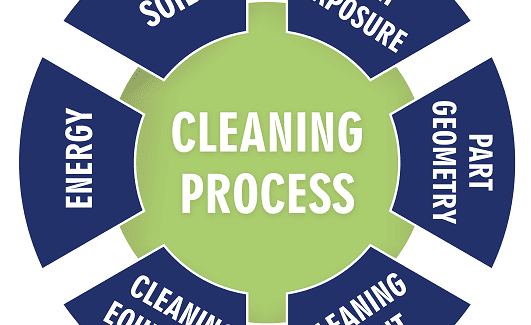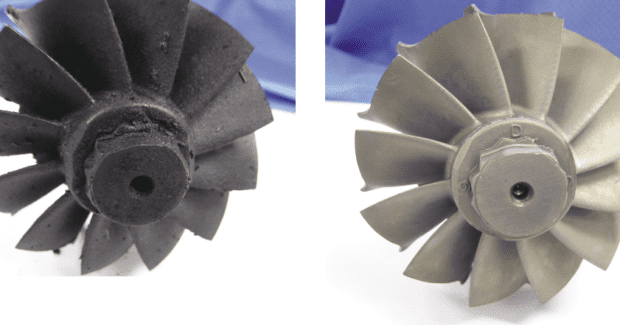Protect Your Cleaning Equipment Investment via an Effective Fluids Program
There are many choices when it comes to selecting cleaning processes and chemistries. Here are a few tips to assist in staying on top of changing technologies to meet your shop’s performance levels.
Posted: December 16, 2021
SMOOTH OPERATIONS
By Joe McChesney
Generally, everything that is manufactured must be cleaned to remove manufacturing oils before transferred to the end user. An often-overlooked key component of operating an effective and efficient cleaning system is to make changes in the cleaning process — not necessarily the equipment. Finding the “right” fit to produce desired results is much easier in today’s info sharing world.
SAFE CLEANING FLUIDS
Safe cleaning chemistries ensure that the cleaning fluids being used are safe not only for the parts being processed, but also for the workers and environment.
How do we ensure the cleaning process becomes effective at a reasonable cost? Changing the type of cleaners you use can be a major part of a successful cleaning strategy.
Many manufacturers face problems with new lubricants or substrate material changes that do not react well with their existing cleaning process or chemistry used. For example, some of the new synthetic lubricants will not clean in the same process system as organic-based lubricants. Some high temperature lubricants require more mechanical action and sometimes need a different cleaning chemistry to remove carbonaceous soils, oxides and smut. Various metals create the need for a new chemistry that is safe for all parts being processed.
Today’s new cleaning agents provide the required performance level to meet the end user’s needs. By using a commonsense approach, select the correct cleaning agent to match the substrates being processed. The “ideal” cleaner can safely remove all the soils in a determined time frame. Mechanical action (such as ultrasonics, high pressure sprays, immersion with bath turbulation, and vertical jogging or rotation) is generally required to supplement the chemical cleaning action. This varies based on your cleaning equipment design.
SOIL MANAGEMENT
By converting to a more efficient cleaning chemistry, the following benefits can be achieved:
- Better cleaning reduces any following manual touch-up or abrasive efforts
- Extended bath life reduces replacement labor/downtime/waste disposal
- Better cleaning decreases process cycle time and increases production throughput
- Soil rejection chemistry extends bath life and reduces operational cost
- Most are multi-metals safe for cleaning a variety of parts in one common chemistry
- Additional benefits yield additional savings
Most current cleaning chemistries have been formulated to meet EPA and OSHA guidelines for ambient air emissions (VOC content and other requirements) and personnel exposure criteria for a safe work environment. Each chemical manufacturer is required to provide pertinent safety information in the Safety Data Sheets (SDS) for the end user’s review and acceptance.
These “new” cleaning agents perform at higher levels while lowering operating costs. They reduce consumables, waste streams and associated labor.
EXTENDING EQUIPMENT LIFE
When your production requires maximum uptime at a sustainable rate, several tasks must be planned and performed to keep the wheels turning smoothly. Most companies have a limited number of cleaning systems vs. multiple production units. Therefore, the importance of any cleaning system operation (aqueous or solvent based process) is paramount for a factory’s needs.
New equipment costs have recently escalated, and delivery time has been extended to many months exceeding past usual deliveries. This fact makes preventative and timely maintenance even more important. Your company has an investment in these systems and the need to protect that investment ranks high on the priority list.
Try to select chemistry which assists separation and removal of process soils (oils, grease, particulate, etc.). Non-emulsifying cleaning chemistry removes the soils from the substrate, then releases it from the solution for separation and removal. This type of chemistry extends bath life, provides cleaner parts and reduces operational cost.
A key benefit to the performance and long-term reliability of the cleaning system by using an “oil splitting” chemistry is extension of the bath life. This feature:
- reduces periodic maintenance periods
- increases production uptime
- reduces waste stream disposal
- lowers overall operational cost in numerous ways
ENVIRONMENTAL IMPACT
The days of operating the system until the cleaning agent is “loaded,” and then dump and replace, have passed. Individual state or local municipal regulations on air emissions discharge, process fluids discharge, and waste stream disposal are in place, but cannot have lower standards than the federal ones. Heavy metals, flammables, corrosive compounds, oil laden compounds and other chemicals must be identified and treated prior to disposal.
Manufacturers must be aware of regulations enacted by the EPA, OSHA, and recommendations/guidelines by other organizations such ACGIH, NIOSH, etc.
Many characteristics and various aspects need to be evaluated. It is recommended that before selecting a new process, compatibility and efficiency testing should be performed. In some cases, one process is generally perceived or proven as superior based on several different inputs, but tests could indicate that it isn’t the most appropriate for your manufacturing needs.
SUSTAINABLE DEVELOPMENT FOR THE FUTURE
Today’s new cleaning agents are replacing the older generation at a rapid pace. Why? Mostly due to required performance and/or compatibility of new components. Some due to EH&S conditions (corporate and/or government). Progress in new cleaning systems that:
- use considerably less chemical agents
- generate low emissions to the atmosphere
- reduce waste streams
- isolate the operator from the process
- decrease process time/increase production uptime
BE INFORMED
There is an abundance of information available to consider the best cleaning method to suit your needs, as well as companies that will perform cleaning analysis of your parts using a specific process to verify the results before you make a commitment. Most are free. Use these resources to supplement your decision.













